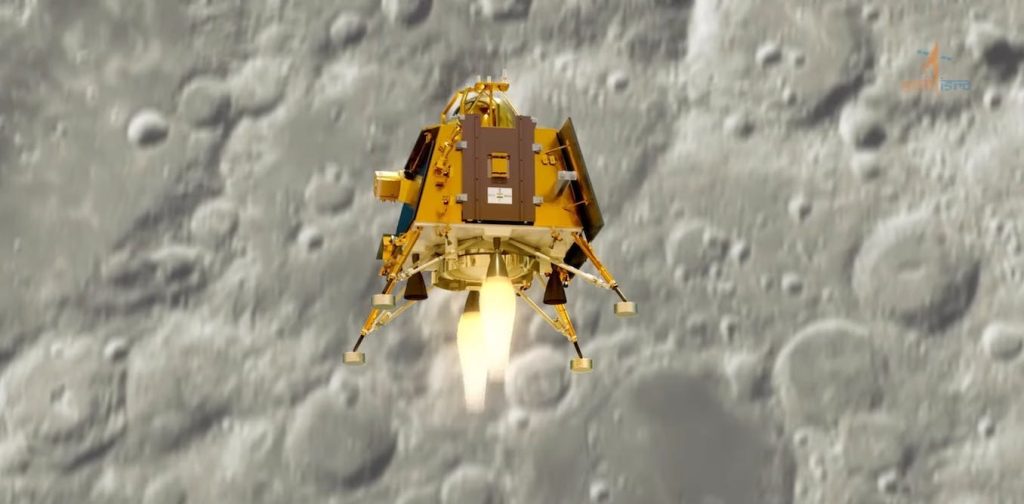On Wednesday August 23, the Indian Space Research Organisation (ISRO) mission Chandrayaan-3 will deploy its lander and rover to the surface of the Moon.
As the name suggests, this is the third mission in a programme of Indian lunar exploration. Various problems affected the previous two Chandrayaan satellites, so officials at the Indian space agency will be hoping for a fully successful mission this time.
So what will Chandrayaan-3 do? We already have some nice images of the lunar surface taken by the lander module camera, which shows the successful separation from its propulsion module – the part that stays in lunar orbit. But the main task for the lander and rover is to show that the ISRO can successfully perform a gentle landing on the Moon.
The lander unit contains four main scientific instruments, including thermal and atmospheric instruments, and a laser retroreflector array. These reflectors are used to measure the distance to the Moon from the Earth to a high degree of accuracy.
ISRO
Essentially, a high power laser is fired towards the Moon and the time taken for the light pulse to reach the Moon, and be reflected back to Earth, is measured. Knowing the speed of light, the time taken (roughly 2.5 seconds there and back) gives us a distance. The lander will also be able to measure moonquakes, weak seismic activity which occurs on a monthly basis.
The speed that the waves travel across the Moon can be used to work out its density and it is hoped that more accurate values for the depth of the lunar crust (its outermost layer) can be calculated.
The rover also contains scientific instrument packages. Its main focus is on identifying the composition of the lunar surface through x-ray spectrometry.
Previous flights
The first mission in the programme, Chandrayaan-1, was launched in 2008. Both subsequent missions share a technological heritage with this original spacecraft. It consisted of a satellite and a probe designed to hit the surface at high speed. For the first year of planned operation, the satellite provided some groundbreaking results, including mapping the Moon in a range of wavelengths. It was looking to determine the composition of the lunar surface, focusing on elements such as calcium, magnesium and iron.
Arguably the most successful result, though, was in conjunction with the onboard moon impact probe. This was a planetary penetrator, which is a small number of instruments packed into aluminium for protection and then fired at the surface. The plan was to prepare for a later lunar rover but the probe also allowed the orbiter to detect liquid water on the lunar surface. Water had long been thought to exist as ice, hidden away in shadowed craters at the Moon’s poles.
The high speed impact of the penetrator threw large numbers of particles from the lunar surface into the atmosphere. By analysing how sunlight is scattered from these particles, their chemical composition can be determined.
The Chandrayaan-1 mission was classed as a success, despite the fact that only half way through its planned mission timeline, communication was lost.
The intention with the second Chandrayaan mission was to take a lander and rover to the lunar surface. The orbiter reached the moon in 2019 and dropped the combined Vikram lander and Pragyan rover to the surface two and a half weeks later.
Unfortunately, in a similar incident to that seen with Chandrayaan-1, communication was lost and the combined mass of almost 1.5 tonnes – roughly the weight of a saloon car – crashed into the surface.
ISRO
Third time lucky
Will this third mission escape the apparent curse that has plagued the previous two? So far, things are looking very hopeful. The mission was launched on July 14 2023 and is currently still communicating with Earth after five weeks.
The deployment of the lander and rover will be the true test, however. If successful, it will mean that India becomes only the fourth country to have had a working rover on the lunar surface behind Soviet Union, US, and China. This will massively improve its reputation for scientific space launches, and potentially gives the agency more leverage for funding future mission planning as well.
An important part of this mission is also the cost of US$75 million (£59 million) – an exceptionally low budget for a research mission leaving the Earth. It is comparable to the cost of a SpaceX Falcon 9 launch. It is worth comparing this cost to the recent Nasa Artemis mission which has future planned costs per launch of US$800 million (£629 million) – not to mention the $13.1 billion (£10.3 billion) development costs over the last 20 years.
The Chandrayaan-2 orbiter is still working, in orbit around the Moon. This means there are options for Chandrayaan-3 in the event that anything should go wrong, as the other satellite can act as a back-up communications platform, reducing the chance of a mission failure.
If successful, the results from both the lander and rover will help scientists scout future lunar landing sites and potential lunar base locations. A knowledge of the landing site is essential for any larger structures, as there is a lot less margin for error due to the higher costs. Being able to build structures out of local resources such as lunarcrete – using lunar soil as a cement-like building material – is a great way to reduce the mass that needs to be launched from Earth. But it also requires the right material to be located nearby.
Personally, I am hoping for Chandrayaan-3’s success, as it seems more and more that private companies are competing to carry out space missions and exploration. With the primary end goal being a commercial one – either tourism or resource collection – it is likely that that scientific discovery will be left out, reduced to an afterthought, or even hindered. So every success by a space agency means more free-to-use data for both the scientific community and the public.

